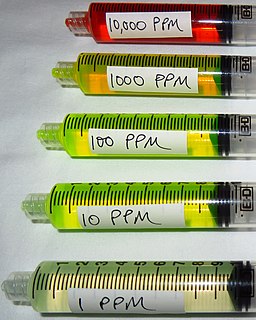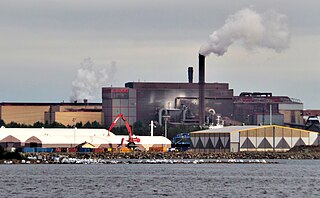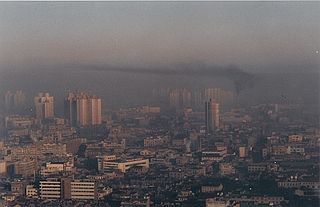
A pollutant is a substance or energy introduced into the environment that has undesired effects, or adversely affects the usefulness of a resource. A pollutant may cause long- or short-term damage by changing the growth rate of plant or animal species, or by interfering with human amenities, comfort, health, or property values. Some pollutants are biodegradable and therefore will not persist in the environment in the long term. However, the degradation products of some pollutants are themselves polluting such as the products DDE and DDD produced from the degradation of DDT.

In science and engineering, the parts-per notation is a set of pseudo-units to describe small values of miscellaneous dimensionless quantities, e.g. mole fraction or mass fraction. Since these fractions are quantity-per-quantity measures, they are pure numbers with no associated units of measurement. Commonly used are ppm, ppb, ppt and ppq. This notation is not part of the SI system and its meaning is ambiguous.
Industrial waste is the waste produced by industrial activity which includes any material that is rendered useless during a manufacturing process such as that of factories, industries, mills, and mining operations. Types of industrial waste include dirt and gravel, masonry and concrete, scrap metal, oil, solvents, chemicals, scrap lumber, even vegetable matter from restaurants. Industrial waste may be solid, liquid or gaseous. It may be hazardous or non-hazardous waste. Hazardous waste may be toxic, ignitable, corrosive, reactive, or radioactive. Industrial waste may pollute the air, the soil, or nearby water sources, eventually ending up in the sea. Industrial waste is often mixed into municipal waste, making accurate assessments difficult. An estimate for the US goes as high as 7.6 billion tons of industrial waste produced every year. Most countries have enacted legislation to deal with the problem of industrial waste, but strictness and compliance regimes vary. Enforcement is always an issue.

Nitrogen dioxide is the chemical compound with the formula NO
2. It is one of several nitrogen oxides. NO
2 is an intermediate in the industrial synthesis of nitric acid, millions of tons of which are produced each year which is used primarily in the production of fertilizers. At higher temperatures it is a reddish-brown gas that has a characteristic sharp, biting odor and is a prominent air pollutant. Nitrogen dioxide is a paramagnetic, bent molecule with C2v point group symmetry.

Environmental chemistry is the scientific study of the chemical and biochemical phenomena that occur in natural places. It should not be confused with green chemistry, which seeks to reduce potential pollution at its source. It can be defined as the study of the sources, reactions, transport, effects, and fates of chemical species in the air, soil, and water environments; and the effect of human activity and biological activity on these. Environmental chemistry is an interdisciplinary science that includes atmospheric, aquatic and soil chemistry, as well as heavily relying on analytical chemistry and being related to environmental and other areas of science.

The U.S. National Ambient Air Quality Standards are standards for harmful pollutants. Established by the United States Environmental Protection Agency (EPA) under authority of the Clean Air Act, NAAQS is applied for outdoor air throughout the country.

An air quality index (AQI) is used by government agencies to communicate to the public how polluted the air currently is or how polluted it is forecast to become. Public health risks increase as the AQI rises. Different countries have their own air quality indices, corresponding to different national air quality standards. Some of these are the Air Quality Health Index (Canada), the Air Pollution Index (Malaysia), and the Pollutant Standards Index (Singapore).
Various governmental agencies involved with environmental protection and with occupational safety and health have promulgated regulations limiting the allowable concentrations of gaseous pollutants in the ambient air or in emissions to the ambient air. Such regulations involve a number of different expressions of concentration. Some express the concentrations as ppmv and some express the concentrations as mg/m3, while others require adjusting or correcting the concentrations to reference conditions of moisture content, oxygen content or carbon dioxide content. This article presents a set of useful conversions and formulas for air dispersion modeling of atmospheric pollutants and for complying with the various regulations as to how to express the concentrations obtained by such modeling.
Exposure assessment is a branch of environmental science and occupational hygiene that focuses on the processes that take place at the interface between the environment containing the contaminant(s) of interest and the organism(s) being considered. These are the final steps in the path to release an environmental contaminant, through transport to its effect in a biological system. It tries to measure how much of a contaminant can be absorbed by an exposed target organism, in what form, at what rate and how much of the absorbed amount is actually available to produce a biological effect. Although the same general concepts apply to other organisms, the overwhelming majority of applications of exposure assessment are concerned with human health, making it an important tool in public health.
The Air Pollution Index (API) is a simple and generalized way to describe the air quality, which is used in Malaysia. It is calculated from several sets of air pollution data. It was formerly used in mainland China and Hong Kong. In mainland China the API was replaced by an updated air quality index in early 2012 and on 30 December 2013 Hong Kong moved to a health based index.
Criteria air Pollutants (CAP), or criteria pollutants, are a set of air pollutants that cause smog, acid rain, and other health hazards. CAPs are typically emitted from many sources in industry, mining, transportation, electricity generation and agriculture. In many cases they are the products of the combustion of fossil fuels or industrial processes.

Air pollution occurs when harmful or excessive quantities of substances including gases, particulates, and biological molecules are introduced into Earth's atmosphere. It may cause diseases, allergies and even death to humans; it may also cause harm to other living organisms such as animals and food crops, and may damage the natural or built environment. Both human activity and natural processes can generate air pollution.

Ozoneweb is an EEA website on near real-time ozone. The website allows the general public to track air quality in a specific region and on a European level. The website displays ozone levels via a map of Europe. Background information on ozone and its health impacts are also provided. Users can monitor ozone levels in a neighbouring country or a holiday destination, check recent trends and track the spread of ozone across Europe. The website now includes a module to display exceedances in countries.
Title 40 is a part of the United States Code of Federal Regulations. Title 40 arranges mainly environmental regulations that were promulgated by the US Environmental Protection Agency (EPA), based on the provisions of United States laws. Parts of the regulation may be updated annually on July 1.
Particulate pollution is pollution of an environment that consists of particles suspended in some medium. There are three primary forms: atmospheric particulate matter, marine debris, and space debris. Some particles are released directly from a specific source, while others form in chemical reactions in the atmosphere. Particulate pollution can be derived from either natural sources or anthropogenic processes.

The Clean Air Act of 1963 is a United States federal law designed to control air pollution on a national level. It is one of the United States' first and most influential modern environmental laws, and one of the most comprehensive air quality laws in the world. As with many other major U.S. federal environmental statutes, it is administered by the U.S. Environmental Protection Agency (EPA), in coordination with state, local, and tribal governments. Its implementing regulations are codified at 40 C.F.R. Sub-chapter C, Parts 50-97.

Air pollutant concentrations, as measured or as calculated by air pollution dispersion modeling, must often be converted or corrected to be expressed as required by the regulations issued by various governmental agencies. Regulations that define and limit the concentration of pollutants in the ambient air or in gaseous emissions to the ambient air are issued by various national and state environmental protection and occupational health and safety agencies.
Drinking water quality standards describes the quality parameters set for drinking water. Despite the truth that every human on this planet needs drinking water to survive and that water may contain many harmful constituents, there are no universally recognized and accepted international standards for drinking water. Even where standards do exist, and are applied, the permitted concentration of individual constituents may vary by as much as ten times from one set of standards to another.

Water quality laws govern the release of pollutants into water resources, including surface water, ground water, and stored drinking water. Some water quality laws, such as drinking water regulations, may be designed solely with reference to human health. Many others, including restrictions on the alteration of the chemical, physical, radiological, and biological characteristics of water resources, may also reflect efforts to protect aquatic ecosystems more broadly. Regulatory efforts may include identifying and categorizing water pollutants, dictating acceptable pollutant concentrations in water resources, and limiting pollutant discharges from effluent sources. Regulatory areas include sewage treatment and disposal, industrial and agricultural waste water management, and control of surface runoff from construction sites and urban environments.
Since the late 1970s, the European Union's (EU) policy has been to develop and drive appropriate measures to improve air quality throughout the EU. The control of emissions from mobile sources, improving fuel quality and promoting and integrating environmental protection requirements into the transport and energy sector are part of these aims.










